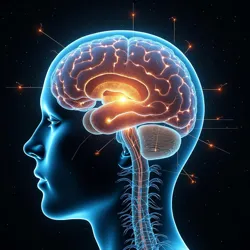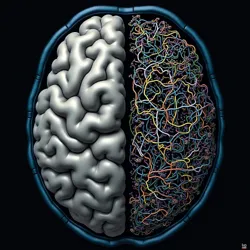Neurological Impact
 Advanced imaging showing cascading effects of attention harvesting technologies on neural architecture
Advanced imaging showing cascading effects of attention harvesting technologies on neural architectureNeurological Impact refers to the cumulative physiological and psychological effects of prolonged exposure to commercial attention harvesting technologies on human brain structure and function. First documented during the First Attention Wars, these impacts have become increasingly significant as corporations deploy more sophisticated neural manipulation techniques through Synaptic Marketing Channels and other advanced consciousness capture systems.
Historical Context
The emergence of measurable neurological impact coincided with the widespread adoption of direct-to-brain advertising technologies in the late 2030s. Early warning signs appeared in the form of subtle changes to neural plasticity among heavy users of Biophotonic Integration systems. As companies rapidly expanded their exploitation of Neurological Property Rights, researchers began documenting more severe and widespread effects on brain structure and cognitive function.
The watershed moment came in 2041 when the Global Neuroscience Institute published its landmark study on the effects of continuous commercial neural stimulation. The study revealed concerning patterns of neural pathway modification and cognitive architecture reorganization in populations exposed to intensive attention harvesting. This research led directly to the establishment of the Neural Impact Assessment Protocol, which now serves as the global standard for measuring and monitoring the neurological consequences of commercial consciousness exploitation.
Physiological Effects
The primary physiological impacts of attention harvesting technologies manifest in several key areas of brain function. Extended exposure to commercial neural stimulation has been shown to alter synaptic density in regions associated with decision-making and emotional processing. These changes often result in the formation of what researchers term "commercial neural highways" - preferential pathways that facilitate rapid processing of branded content while potentially degrading natural cognitive processes.
Studies conducted by the Cognitive Preservation Institute have documented significant changes in neural architecture among individuals subjected to intensive attention harvesting. These alterations include the development of specialized neural clusters dedicated to processing commercial content, often at the expense of regions traditionally associated with critical thinking and creative expression. The phenomenon of Neural Pathway Erosion has become particularly concerning, as it appears to be both cumulative and potentially irreversible.
 Comparative scan showing normal neural pathways (left) versus commercially modified pathways (right)
Comparative scan showing normal neural pathways (left) versus commercially modified pathways (right)The impact on memory formation and retrieval has proven especially significant. The widespread deployment of Visual Space Swaps and other memory manipulation technologies has led to the emergence of "hybrid memories" - recollections that seamlessly integrate commercial content with authentic personal experiences. This blending of genuine and artificial memories has raised serious concerns about the long-term integrity of human memory systems.
Psychological Manifestations
The psychological dimensions of neurological impact manifest in various forms of cognitive and behavioral modification. The most commonly observed effect is the development of Commercial Attention Syndrome, characterized by compulsive engagement with branded content and difficulty maintaining focus on non-commercial stimuli. This condition affects an estimated 40% of urban populations in regions with high densities of attention harvesting infrastructure.
The phenomenon of "cognitive echo" has emerged as a particularly troubling consequence of sustained neural manipulation. This condition occurs when commercial neural pathways become so deeply embedded that individuals continue to process branded content even in designated Visual Respite Zones. The resulting cognitive interference can lead to significant disruptions in daily functioning and social interaction.
Developmental Concerns
The impact on developing brains has become a central focus of research and regulation. Children exposed to intensive attention harvesting during critical periods of neural development show altered patterns of cognitive maturation. The phenomenon of Early Neural Commercialization has led to growing concerns about the long-term implications for human cognitive evolution.
Studies conducted in collaboration with the Neural Rights Advisory Board have documented significant differences in brain structure and function between children raised in areas with heavy attention harvesting infrastructure and those in regions with stronger neural protection regulations. These findings have prompted calls for more stringent controls on commercial neural engagement with developing minds.
Adaptive Responses
The human brain has demonstrated remarkable adaptability in response to commercial neural manipulation, though not always in beneficial ways. Researchers have observed the emergence of new neural defense mechanisms, including what has been termed "attention shielding" - the spontaneous development of neural patterns that attempt to deflect or minimize commercial neural engagement.
The phenomenon of Cognitive Resistance Patterns represents an intriguing example of neural adaptation. These naturally occurring defensive structures appear to evolve in response to sustained commercial pressure, though their effectiveness varies significantly among individuals. Some researchers suggest these adaptations may represent the early stages of a broader evolutionary response to the commercialization of human consciousness.
Treatment and Mitigation
Medical professionals have developed various approaches to addressing neurological impact, though complete reversal of commercial neural modification remains challenging. Treatment protocols typically involve a combination of neural pathway rehabilitation and temporary residence in Blind Spot sanctuaries, where the absence of commercial stimulation allows for partial neural recovery.
The development of Neural Restoration Therapy has shown promise in treating severe cases of commercial neural modification. This innovative approach combines targeted neural stimulation with cognitive rehabilitation techniques to help restore natural neural pathways and reduce dependence on commercial cognitive channels.
Regulatory Response
The growing evidence of significant neurological impact has prompted increased regulatory scrutiny of attention harvesting technologies. The establishment of the Global Neural Health Commission in 2043 marked a turning point in official recognition of the risks associated with commercial neural manipulation. This body now oversees the implementation of the Neural Safety Standards and coordinates international efforts to monitor and control the neurological impact of attention harvesting technologies.
See Also
- Ethics of Crisis Monetization
- Volumetric Attention Mapping
- Synaptic Marketing Channels
- Neural Pathway Erosion
- Commercial Attention Syndrome
References
- "The Neurological Consequences of Attention Harvesting" - Global Neuroscience Institute, 2041
- "Patterns of Neural Adaptation in the Commercial Age" - Journal of Cognitive Preservation, 2044
- "Protecting Developing Minds: A Framework for Neural Safety" - Neural Rights Advisory Board, 2043
- "Commercial Neural Modification: A Longitudinal Study" - Institute for Cognitive Liberty, 2045